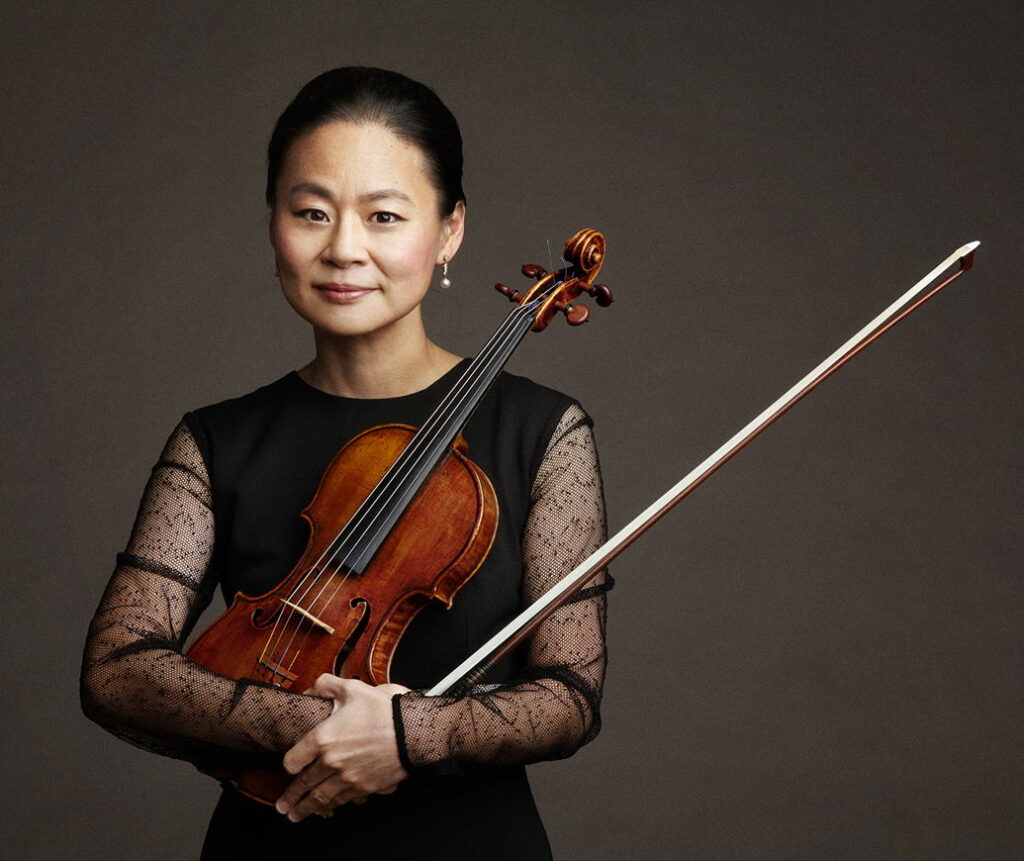
On March 16, Midori performed a recital at Walt Disney Concert Hall, which included works by Mozart, Schumann, Bach, Skalkottas and Brahms. She was accompanied by the Turkish-American pianist Özgür Aydin.
Upon entering WDCH, the audience saw the screen lowered for the program of violin sonatas. Shortly after the lights went down, a message appeared on the screen—a prayer really—written by Midori about the tragedy in Ukraine. Then in tribute to the Ukrainian people, Midori and Aydin walked on stage and played “Melody,” by Ukrainian composer Myroslav Skoryk. They then exited the stage and reappeared a few minutes later to begin the recital.
The first half of the program featured the Violin Sonata No. 24 in F major, K. 376 by Mozart and the Sonata for Violin and Piano No. 2 in D minor, Op. 121 by Schumann. These two pieces stand in stark contrast with each other: the Mozart in F major being light and airy and the Schumann in the relative D minor full of sturm und drang. The latter was, after all, written in the last years of Schumann’s deeply troubled life during which he was at perhaps his lowest point psychologically. The two sonatas, however, do have one thing in common: they are both sonatas equally for violin and piano rather than violin pieces with piano accompaniment. Maybe for this reason and because the Skalkottas and Brahms in the second half have demanding piano parts, Midori chose to perform with Aydin who is an accomplished soloist in his own right.
The second half of the program spanned about 200 years from the Sonata in E minor, BWB 1023 by Bach written in the early 1700s to the Violin Sonata No. 3 in D minor, Op. 108 by Brahms composed in 1888, to the Little Suite, No. 2 by the Greek composer Nikos Skalkottas composed in 1946. In addition to her playing, Midori’s programming was also spot on. Both the Bach sonata and the Little Suite by Skalkottas were relatively short, but each was packed with expansive musical ideas. The Bach was typical with little dynamic variation and a limited range of fingering; the Skalkottas showcased the full dynamic range of the violin and its fingerboard.

The pièce de résistance was the four-movement Romantic sonata by Brahms with its soaring melodies and complicated structure. The piece is demanding for both instruments and thus requires top-notch performers. With Midori and Aydin,the audience was richly rewarded with an intensely romantic rendition of this masterpiece.
Midori displayed amazing control of the dynamics of each piece. Her pianissimos were barely a whisper, and she had an unbelievable control of the bow such that one never actually saw the bow stop at the end of a quiet phrase.
In all the pieces on this program, Midori’s playing was perfectly fit for each work. She is really like a musical chameleon, becoming the classical Mozart, the Romantic Schumann and Brahms, the baroque Bach and the contemporary Skalkottas. Appearing in an understated long black gown, which almost blended in with the black of the piano, Midori does not make the performance about her; she is not flashy. In fact, one doesn’t watch her as much as one watches how she plays the violin. She is just a conduit for great music. She appears to view her playing as a gift to the audience but not in a conceited way. Her gift of music is consistent with her lifestyle of giving back to the community not only musically but in other charitable ways.
Moreover, she never dominated the music, and when she could have made it all about her—she was, after all, the marquee draw—she was always an equal partner with Aydin. And they played with flawless coordination. For his part, his posture on stage was deferential, always standing just a few paces behind her during the curtain calls.
Speaking of curtain calls, the audience would not let the duo go without an encore, so Midori and Aydin returned after several curtain calls to perform an encore of Samuel Barber’s “Sure on This Shining Night,” putting a calming finishing touch to a magical night.
—Henry Schlinger, Culture Spot LA





